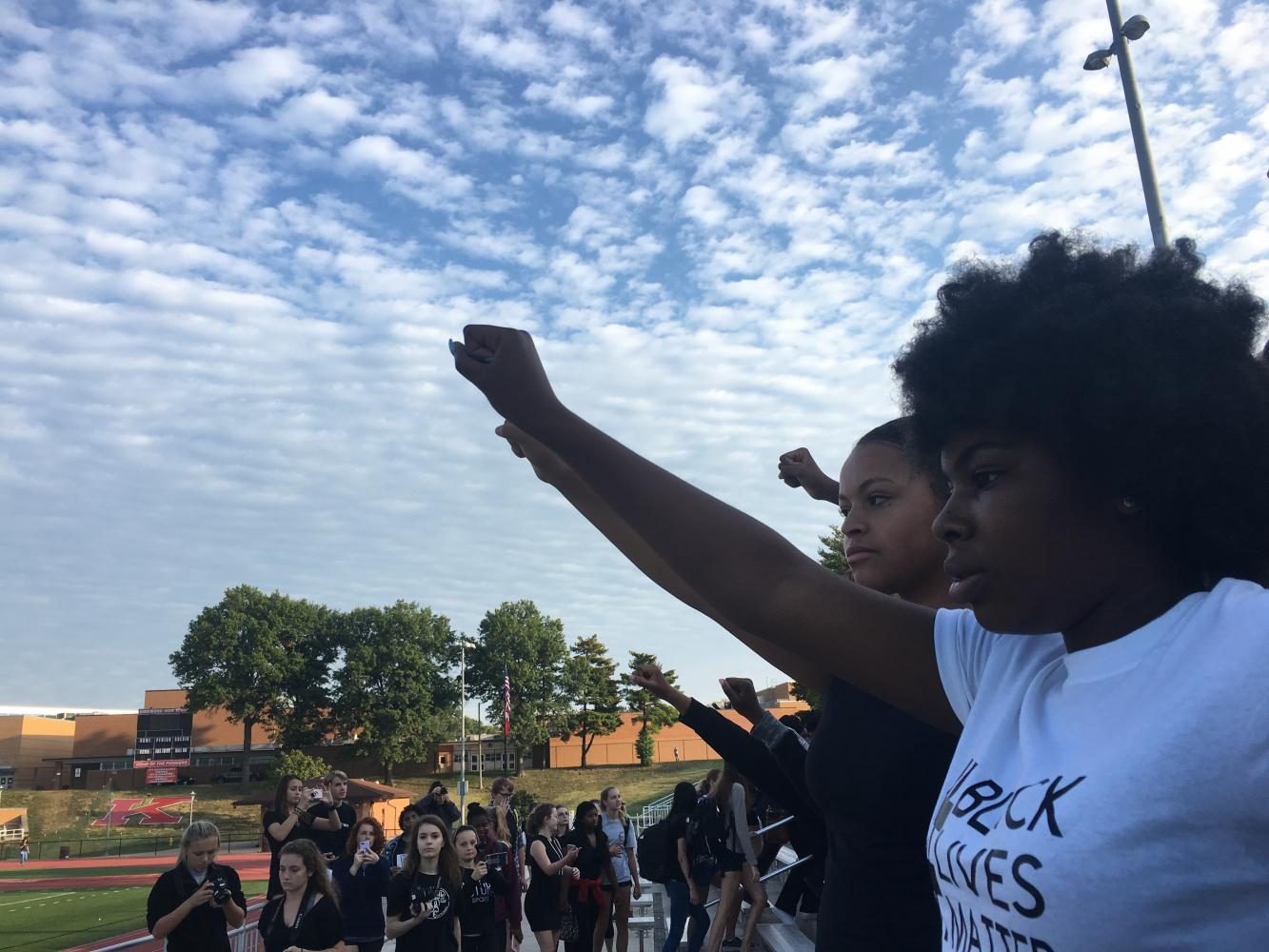How to Walk Out
Sha’diya Tomlin, leader of the walkout, raises her fist in the air. The walkout is in response to the Jason Stockley verdict that rocked the St. Louis area on Friday.
As political activism finds its way into America’s schools, so does debate over how it should be displayed. While activists may share political opinions, they have adverse approaches on how to demonstrate them. KHS was no stranger to political activism after students organized a walkout protesting the acquittal of Officer Jason Stockley, and then another walkout protesting loose gun laws in response to the mass shooting at Marjory Stoneman Douglas High School in Parkland, Florida. As soon as word spread about the Stockley protest, conversation at KHS on “how to walk out” began. While Bismah Syed, sophomore, had an overall positive opinion on both walkouts, she acknowledged inconsistencies between the protests. She regularly participates in political activism and walked in the Stockley walkout.
“The way that Kirkwood did [the Parkland walkout], kind of took the attention away from the very first [Stockley] walkout that we did,” Syed said. “There were a lot more people that attended the second walkout.”
Madeline Raimondo, social studies teacher, experienced her first KHS walkout in 2014, after the murder of Michael Brown. She said that everyone should have had the ability to walkout for their own cause, but it was also important to credit the movement that originally inspired this new era of youth in political activism.
“The students in the Stockley walkout, and to go back even further to 2014 after Ferguson, opened the doors and showed how to do this.” Raimondo said. “It allowed the students who walked out after Parkland to see that and learn from it so they were able to do that themselves, so I think that it’s important for us to recognize the bravery of those students who were able to use their voice early on.”
Kelsey Perry, senior, attended both walkouts. She said the passion of the students was consistent through both protests, even if there were less people at the Stockley walkout. She said the controversy of the events that sparked the first walkout may have discouraged students from participating, but that the turnout must have mostly depended on leadership and communication. Syed said that since schools were demonstrating nationwide and the staff saw the walkout coming, students may have felt more comfortable to join the Parkland walkout. After the new strict attendance policy, there was controversy over students receiving an unexcused absence for walking out. Raimondo touched on the fact that some students may have felt discouraged by the staff. She suggested that while the unexcused absence was necessary to prepare students to make sacrifices for political action outside of KHS, staff should have interacted with the students more.
“If we are giving them that consequence [the unexcused absence], how are going to show that we support student voice too?” Raimondo said. “When something like [a walkout] is going on I think it’s important to debrief that in class so that students know that they should have a voice.”
Perry said the importance of the unexcused absence was that it held students accountable, while also ensuring that students participating were truly passionate about the message.
“In a way, [the unexcused absence] adds fire to [the walkout].” Perry said. “Using an absence is a risk and it shows how much we care.”
Syed shares a different opinion. She said that there should have been excused absences given for the Parkland walkout, considering it was a nationwide event. Despite the contrasting perspectives on the walkouts, both Syed and Perry describes the demonstrations as a positive learning experience for students.
“I learned a lot about student leadership.” Syed said. “It was a really cool experience to see schools come together and share their opinions on this issue.”
Syed mainly hopes the walkout inspired students to participate in other forms of more effective and direct political change.
“Lobbying and writing your senators is a huge thing.” Syed said. “There are ways that you can text messages to your senators and even though it seems like such a small thing to do, it does make a huge difference.”
Perry agreed that students should be encouraged to take further action.
“Getting together and organizing a petition or volunteering for an organization is really helpful because you’re effectively contributing to a cause.” Perry said.
In terms of more effective ways to spread political awareness on campus, Syed suggests panels or assemblies where people can discuss and debate controversial opinions. Perry said that the walkout provided a safe space, where issues such as mental health or race could be discussed to unite students.
“I definitely learned that a lot more people were on the same side of me than I thought,” Perry said. “There were people there that I thought would never attend a walkout, so that was really cool.”
Although students may disagree on exactly how the demonstration could have effectively been executed, they can definitely agree on the importance of bringing students together and preparing them to be leaders of the future.
“Students are the future and the voters of tomorrow.” Syed said. “They should take every opportunity they have, it’s worth it to try your best and do everything in your power to make change.”
Your donation will support the student journalists of Kirkwood High School. Your contribution will allow us to purchase equipment and cover our annual website hosting costs.



